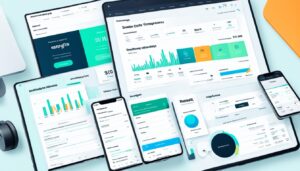As an Amazon seller, efficient inventory management is crucial for success and profitability. FBA inventory replenishment plays a significant role in ensuring that your stock levels are always optimized to meet customer demand, without risking stockouts or excess inventory. Without proper Amazon FBA inventory management, you risk losing sales and customers to competitors who are effectively replenishing their stock.
In this section, we will explore the importance of FBA inventory replenishment and planning, and how it can help you achieve your long-term sales goals on Amazon. We will discuss Amazon FBA inventory management system and its features, and share effective strategies for FBA inventory planning and replenishment. Additionally, we will highlight key metrics to monitor and leverage to optimize your inventory replenishment efforts and discuss available technology solutions to simplify and streamline replenishment processes.
By mastering FBA inventory replenishment and management, you can stay competitive, increase sales, and maximize profits on the Amazon platform.
Key Takeaways:
- Efficient inventory management is crucial for success and profitability on Amazon.
- FBA inventory replenishment helps maintain optimal stock levels to meet customer demand without risking stockouts or excess inventory.
- Effective FBA inventory planning strategies include forecasting demand, determining optimal stock levels, and setting up automated replenishment processes.
- Key metrics to monitor for FBA inventory replenishment optimization include sell-through rate, replenishment lead time, and inventory turnover.
- Technology solutions are available to simplify and streamline FBA inventory replenishment processes.
Why FBA Inventory Replenishment Matters for Success
As an FBA seller, managing your inventory is crucial for achieving success on the Amazon platform. While it may seem like a straightforward task, the risks of understocking or overstocking can have a significant impact on your sales and customer satisfaction.
Replenishing FBA inventory is critical, as it ensures that you always have enough stock to meet demand. On the other hand, overstocking leads to high storage fees and can result in slow-moving inventory and reduced profits. Inventory management for FBA sellers requires a delicate balance between these two factors, and careful consideration of your sales data, trends, and seasonality.
FBA stock replenishment is not a one-time event, but rather an ongoing process that requires continuous monitoring and adjustment. By implementing effective inventory management strategies, you can minimize the risks of stockouts or excess inventory, optimize your storage space, and boost your sales performance.
The Impact of Poor Inventory Management
The consequences of poor inventory management can be severe for FBA sellers. On one hand, understocking leads to missed sales opportunities, low customer satisfaction, and a decrease in your Amazon search rankings. On the other hand, carrying too much inventory can lead to increased storage fees, a decrease in profit margins, and obsolescence.
As an FBA seller, it’s essential to stay on top of your inventory levels and replenish stock in a timely manner. By doing so, you can improve your customer experience, increase your visibility on the Amazon platform and ultimately drive sales growth.
Understanding Amazon FBA Inventory Management
Amazon’s FBA inventory management system is an integral part of the FBA selling process. It allows sellers to store their products in Amazon’s fulfillment centers, which handle everything from storage and shipping to customer support and returns. By leveraging Amazon’s extensive logistics infrastructure, FBA sellers can focus on growing their business without having to worry about the operational complexities.
Proper inventory management is critical for FBA sellers to ensure they have enough stock to meet demand while avoiding inventory overstock or understock situations that can negatively affect their sales. Amazon FBA inventory management offers various features to help sellers optimize their inventory levels and avoid stockouts, such as automated replenishment and inventory forecasting tools. By using these tools, FBA sellers can have a better understanding of their inventory needs and make data-driven decisions to ensure their inventory is always up-to-date.
Efficiently managing inventory with Amazon FBA not only optimizes operations but also improves customer experience. By having fast and reliable fulfillment, Amazon gains customer trust and loyalty, which results in higher customer satisfaction rates and increased positive reviews. These factors, in turn, lead to higher sales and profitability for FBA sellers.
Overall, FBA selling with proper inventory management is a winning strategy for any Amazon seller who wants to remain competitive and maximize their profits. By understanding Amazon’s FBA inventory management system and implementing effective inventory management practices, sellers can streamline their operations and ensure they have the right inventory levels to meet demand.
Effective FBA Inventory Planning Strategies
Proper FBA inventory planning is crucial to ensure optimal stock levels without excess inventory. Here are some effective FBA inventory replenishment strategies:
1. Forecast Demand
Accurate forecasting is crucial to avoid running out of stock or overstocking. Use historical sales data and market research to anticipate demand and plan inventory accordingly.
2. Determine Optimal Stock Levels
Setting the right stock levels is essential for efficient FBA inventory replenishment. Use analytics tools to determine the right stock levels based on demand, lead time, and safety stock.
3. Set Up Automated Replenishment
Automating your FBA inventory replenishment process can save valuable time and resources. Use Amazon’s automation tools, such as Amazon’s Sales and Inventory Report and Inventory Dashboard, to set up automated restocking.
4. Monitor Performance Metrics
Track key metrics such as sell-through rate, replenishment lead time, and inventory turnover to monitor the performance of your FBA inventory replenishment strategy. This will allow you to make necessary adjustments and optimize your process over time.
“Proper inventory management and planning can make or break your FBA business. By implementing these effective strategies, you can ensure optimal stock levels while minimizing excess inventory and maximizing profits.”
Key Metrics for FBA Inventory Replenishment
Monitoring your inventory replenishment metrics is critical to staying ahead of the game on Amazon. Here are the key metrics that all FBA sellers should monitor in order to optimize their inventory planning and replenishment:
Sell-Through Rate
One of the most important metrics to track is your sell-through rate. This metric helps you determine how fast you are selling your inventory, which is crucial for planning your reorder quantities and timing. To calculate your sell-through rate, divide the total number of units sold by the average number of units in stock during the selling period. Keeping a high sell-through rate helps you maintain steady sales and avoid stock build-up.
Replenishment Lead Time
Replenishment lead time refers to the amount of time it takes for you to receive your inventory after placing an order with your supplier. It is important to factor in this time when planning your reorder schedule to avoid running out of stock. Calculating this metric involves evaluating the entire process from the time you place your order to the time you receive it in your FBA warehouse.
Inventory Turnover
Inventory turnover is another important metric for FBA inventory replenishment. This metric measures the rate at which your inventory is being sold and restocked over a specific period of time. By dividing the cost of goods sold by the average inventory value during that period, you can determine your inventory turnover. A high turnover rate indicates that you are efficiently managing your inventory and avoiding overstocking, which can lead to less waste and higher profits.
By monitoring these key metrics and using the insight gained to drive your inventory planning and replenishment strategy, you can optimize your sales and avoid costly errors in managing your FBA inventory.
Leveraging Technology for Efficient FBA Inventory Replenishment
With the increasing complexity of Amazon FBA inventory management, leveraging technology solutions has become essential for companies to remain competitive. There are several inventory management tools and automation software that can help simplify and streamline your replenishment processes, including:
Inventory Management Tools
These tools help you identify which products require restocking, track FBA inventory levels, and forecast the demand for products. By analyzing data from your sales history and inventory levels, these tools will help optimize your inventory and prevent stockouts or overstocks.
Automation Software
Automated inventory replenishment software can track and analyze real-time sales data to automatically trigger orders when stock levels reach a certain threshold. This process not only saves time but also ensures that you are always well-stocked and reduces the chances of selling out-of-stock products.
Tip: Check out Amazon’s Amazon FBA Replenishment Service, which automatically ships products to Amazon’s warehouse based on predetermined levels that you set.
Integration Options
Integrating your inventory management software with Amazon’s FBA platform can add additional benefits such as real-time order and inventory tracking, automated shipment creation, and order accuracy.
Benefits of Leveraging Technology
Implementing these technology solutions can help you avoid stockouts, reduce excess inventory, and optimize your inventory replenishment processes. In addition, you can save time and resources by automating manual processes, allowing you to focus on scaling your business and customer satisfaction.
Best Practices for FBA Inventory Replenishment
Effective inventory management is crucial for FBA sellers to avoid stockouts, overstocks, and unsatisfied buyers. Follow these best practices for optimizing your FBA inventory replenishment:
- Set up reorder triggers: Determine the minimum stock level for each SKU and establish rules for reorder to replenish inventory before stockout occurs.
- Optimize product listing: Use data-driven optimization to identify the most effective keywords, images, and product descriptions to increase visibility and sales of your FBA inventory.
- Manage seasonality: Anticipate demand shifts in accordance with the holidays, weather and time of year by creating a well-designed sales forecast.
- Streamline processes: Automate inventory management systems with the help of technology, and keep track of key metrics, such as lead time and inventory turnover.
By following these best practices, FBA sellers can ensure effective inventory management and avoid common pitfalls associated with FBA inventory replenishment.
Troubleshooting Common Challenges in FBA Inventory Replenishment
While FBA inventory replenishment can boost your sales and enhance your customer experience, it comes with its own set of challenges. Several factors can impede the smooth flow of your inventory, causing unexpected stockouts or overstocks. To ensure that your inventory management runs smoothly, we’ve rounded up some of the common challenges that FBA sellers face and the solutions to overcome them.
Stockouts
Stockouts occur when you have no inventory to fulfill your customer’s orders. It usually results in the loss of sales, decreased customer satisfaction, and lowered search rank. One way to avoid stockouts is replenishing your inventory regularly. Analyzing your sales rate and setting reorder triggers can help you maintain optimal stock levels while ensuring a consistent supply of goods for your customers.
Overstocks
Overstocks happen when you have too much inventory on hand, resulting in a waste of valuable resources. It can also lead to long-term storage fees charged by Amazon. To avoid overstocks, you need to monitor your inventory levels closely and anticipate changes in demand. By using inventory forecasting tools, you can make informed decisions on when to replenish your inventory to avoid overstocks.
Unexpected Demand Fluctuations
Changes in demand driven by seasonality, trends, or unforeseen events can impact your inventory levels and cause imbalances in your stock. To mitigate these unexpected fluctuations, consider implementing an automated inventory management system that utilizes data analysis and alerts you of any potential issues before they occur. You can also use Amazon FBA’s Multi-Channel Fulfillment (MCF) service to divert your inventory to other channels or marketplaces, preventing stockouts during peak demand periods.
Miscalculating your Replenishment Level
Calculating the optimal replenishment level for your inventory can be challenging, as it involves balancing several factors such as sales rates, lead times, and forecasting accuracy. One way to overcome this challenge is to use inventory management software that allows you to set reorder points and reorder quantities easily. By doing so, you can ensure that you always have enough stock on hand without overstocking or understocking your inventory.
In summary, Amazon FBA inventory management is a complex process that requires constant attention and monitoring. By understanding the common challenges and implementing strategies to overcome them, you can streamline your inventory management and improve your Amazon FBA selling experience.
The Future of FBA Inventory Replenishment
As technology continues to evolve, the future of FBA inventory replenishment looks bright. With emerging trends such as artificial intelligence-driven forecasting and predictive analytics, FBA sellers can look forward to even more efficient and precise inventory management in the years to come.
One of the most significant advancements in technology for FBA inventory planning is AI-powered demand forecasting. Using machine learning algorithms, AI can analyze vast amounts of data to provide accurate predictions of future demand, allowing sellers to optimize their inventory levels and avoid stockouts and overstocking.
Predictive analytics is another exciting development in the FBA inventory management space. By leveraging data and statistical algorithms, predictive analytics can help sellers identify trends and patterns in customer behavior, enabling them to make informed decisions about inventory planning and restocking.

As FBA sellers continue to adapt to the changing landscape of e-commerce, new technologies and innovations will undoubtedly play a critical role in driving future growth and success.
Conclusion
Efficient FBA inventory replenishment is crucial for Amazon sellers seeking long-term success. Proper inventory management allows you to plan your stock levels and automate replenishment processes, ensuring that you never run out of stock or end up with excess inventory. To optimize your FBA inventory management, it is important to track key metrics such as sell-through rate and replenishment lead time and to leverage technology solutions such as inventory management software and automation tools.
By following best practices for FBA inventory replenishment, including effective forecasting and inventory planning strategies, you can stay ahead of the competition and maximize profits. As the field of FBA inventory replenishment continues to evolve, it is important to stay informed about emerging trends and future developments. With the right approach, FBA inventory replenishment can be a powerful tool for Amazon sellers looking to grow their business and achieve peak performance.
Master FBA inventory replenishment today and take your Amazon FBA inventory management to the next level!
Learn More About Amazon FBA
FAQ
What is FBA inventory replenishment?
FBA inventory replenishment refers to the process of restocking your inventory in Amazon’s Fulfillment by Amazon (FBA) program. It involves managing and planning your stock levels to ensure a continuous supply of products to meet customer demand.
Why is FBA inventory replenishment important?
FBA inventory replenishment is crucial for the success of your Amazon selling business. By maintaining optimal stock levels, you can avoid stockouts and keep your products available for purchase, improving sales and customer satisfaction.
How can effective inventory management benefit FBA sellers?
Effective inventory management can benefit FBA sellers by reducing storage costs, minimizing products’ time spent in warehouses, and improving order fulfillment efficiency. It also helps maintain product visibility and ensures timely delivery, ultimately enhancing customer experience and generating repeat business.
What are some effective FBA inventory planning strategies?
Effective FBA inventory planning strategies include analyzing historical sales data, monitoring market trends, implementing demand forecasting techniques, and setting up automated replenishment processes. These strategies help you optimize stock levels, reduce overstocking or understocking risks, and improve overall inventory turnover.
What are the key metrics for FBA inventory replenishment?
Key metrics for FBA inventory replenishment include sell-through rate, replenishment lead time, turnover rate, and carrying cost. Monitoring and analyzing these metrics can help you make informed decisions about when and how much inventory to reorder.
How can technology help with FBA inventory replenishment?
Technology solutions such as inventory management tools and automation software can streamline your FBA inventory replenishment process. They can help automate tasks, provide real-time data insights, and integrate seamlessly with your Amazon account, saving you time and improving accuracy.
What are some best practices for FBA inventory replenishment?
Best practices for FBA inventory replenishment include setting up reorder triggers based on sales velocity, optimizing product listings with relevant keywords and attractive images, monitoring seasonal trends, and establishing effective communication with suppliers. It’s also crucial to regularly review and adjust your replenishment strategy based on market changes and customer demand.
How can sellers troubleshoot common challenges in FBA inventory replenishment?
Sellers can troubleshoot common challenges in FBA inventory replenishment by closely monitoring inventory levels, using safety stock buffers, adjusting reorder points based on demand fluctuations, and utilizing sales data analysis to anticipate and respond to market trends. Building good relationships with suppliers and staying informed about industry trends can also help overcome challenges.
What is the future of FBA inventory replenishment?
The future of FBA inventory replenishment is likely to be driven by advancements in technology. Artificial intelligence, machine learning, and data analytics will play a significant role in improving demand forecasting accuracy, optimization of inventory levels, and automating replenishment processes, ultimately enhancing the efficiency and profitability of FBA selling.




